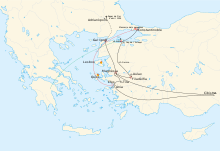
Back Каталонска кампания Bulgarian Campanya de la Gran Companyia Catalana a Anatòlia Catalan Καταλανική εκστρατεία στη Μικρά Ασία Greek Campaña Catalana en Asia Menor Spanish Campagna catalana (Asia minore) Italian Каталонски поход Macedonian Campania catalană din Asia Mică Romanian Küçük Asya Katalan Seferi Turkish
You can help expand this article with text translated from the corresponding article in Italian. (July 2020) Click [show] for important translation instructions.
|
| Catalan Campaign in Asia Minor | |||||||
|---|---|---|---|---|---|---|---|
 | |||||||
| |||||||
| Belligerents | |||||||
|
Catalan Company (until 1305)[1] |
Various Anatolian Turkish Beyliks Catalan Company (after 1305)[1] | ||||||
| Commanders and leaders | |||||||
|
Roger de Flor (before 1305) |
Roger de Flor X (1305) Berenguer d'Entença | ||||||
| Strength | |||||||
| 10,900 in total (see "strength of forces") | 30,000 men, according to Ramon Muntaner | ||||||
| Casualties and losses | |||||||
| Only about 1,500 Catalans remained, according to Ramon Muntaner | 18,000 supposedly lay dead, according to Ramon Muntaner | ||||||
In 1303, the Byzantine Emperor Andronicus II Palaeologus hired 6,500 Catalan mercenaries under Roger de Flor[2] to campaign against the Turks in the spring and summer of the same year. Their costly service came with success, driving back the Turks in parts of Asia Minor.[3] At Philadelphia, 18,000 Turkish soldiers (possibly those of Aydinids) were left dead, the work of the Catalans.
However, the Byzantines got more than what they bargained for; the mercenaries were difficult to restrain and consequently much of the reconquered territory was laid to waste. When their leader Roger de Flor was assassinated in Gallipoli on 3 April 1305 by Michael IX Palaeologus followed by a massacre of 1,300 Catalans,[2] the mercenaries began a two-year pillage in revenge and crossed over to Thrace and Macedonia under the command of their new leader, Berenguer d'Entença,[3] where further raiding occurred. As a result of this brutality, the Company was excommunicated by Pope Clement V.[3] Eventually the Catalan mercenaries claimed the Duchy of Athens for themselves in 1311 and would remain there until 1379,[3] leaving behind a devastated Byzantium. After this, the Turks found much support amongst those who suffered and reoccupied land that had been lost.
Thus, the Catalans' campaign was a short-term Byzantine victory, but benefited the Turks in the long term.
- ^ a b Ágoston, Gábor; Masters, Bruce Alan (2009). Encyclopedia of the Ottoman Empire. Infobase Publishing. p. 232. ISBN 9781438110257.
- ^ a b Cite error: The named reference
cataloniawas invoked but never defined (see the help page). - ^ a b c d Rogers, Clifford (2010). The Oxford Encyclopedia of Medieval Warfare and Military Technology. Oxford University Press. p. 350. ISBN 9780195334036.